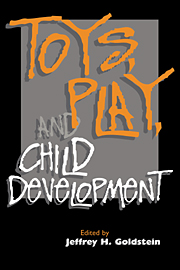Book contents
- Frontmatter
- Contents
- Acknowledgments
- List of contributors
- Introduction
- 1 Imaginative play and adaptive development
- 2 Play, toys, and language
- 3 Educational toys, creative toys
- 4 The war play debate
- 5 War toys and aggressive play scenes
- 6 Sex differences in toy play and use of video games
- 7 Does play prepare the future?
- 8 Play as healing
- References
- Name index
- Subject index
7 - Does play prepare the future?
Published online by Cambridge University Press: 07 October 2009
- Frontmatter
- Contents
- Acknowledgments
- List of contributors
- Introduction
- 1 Imaginative play and adaptive development
- 2 Play, toys, and language
- 3 Educational toys, creative toys
- 4 The war play debate
- 5 War toys and aggressive play scenes
- 6 Sex differences in toy play and use of video games
- 7 Does play prepare the future?
- 8 Play as healing
- References
- Name index
- Subject index
Summary
It is possible to argue that there are two major kinds of rhetoric about play in this century. One says that play is a preparation for the future, the other that play is a form of adjustment to the present. We associate the preparatory theory with the Reformation, the Enlightenment, historicism, evolutionary theory, biology and developmental psychology, and more recently with feminism, and in all cases with its application to children. We associate the adjustment theory with Romanticism, with Freud, with phenomenology, and, most appropriately, with its application to adults, because it is hard to say that adults grow as a result of their play. Adults more often seem to be fixated in one place, incurably addicted to their pastimes. The preparatory view is optimistic; the adjustment view is probably pessimistic. There is always some hope for the young but not much for the old. The former view has to do with progress, the latter with contentment. Progress is a much harder master.
My Bundle Baby
In order to give some currency to this discussion of whether play prepares one for the future, I begin by focusing on a controversial toy that has just come onto the American market after being heralded at the international Toy Fair in New York in February 1992. The toy is a doll for 3- to 7-year-olds called My Bundle Baby. It is a typical spongy, soft doll, 11 inches tall.
- Type
- Chapter
- Information
- Toys, Play, and Child Development , pp. 130 - 146Publisher: Cambridge University PressPrint publication year: 1994
- 8
- Cited by



